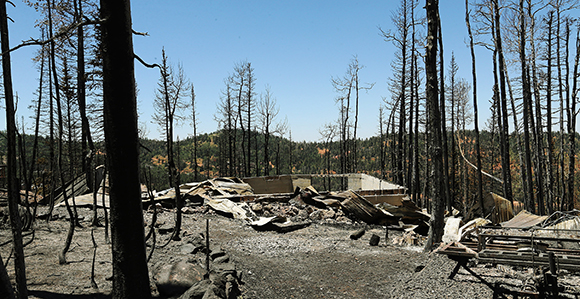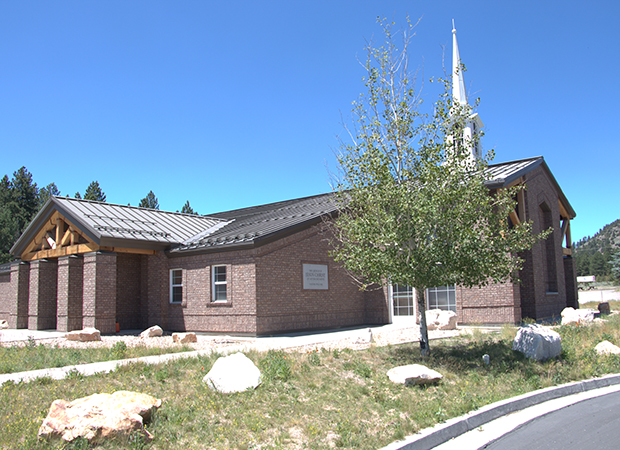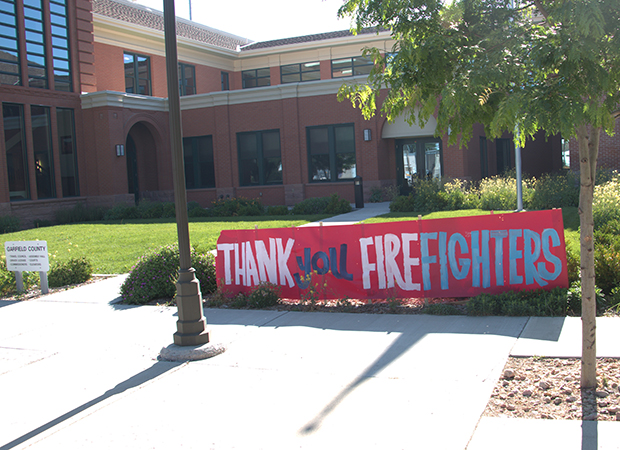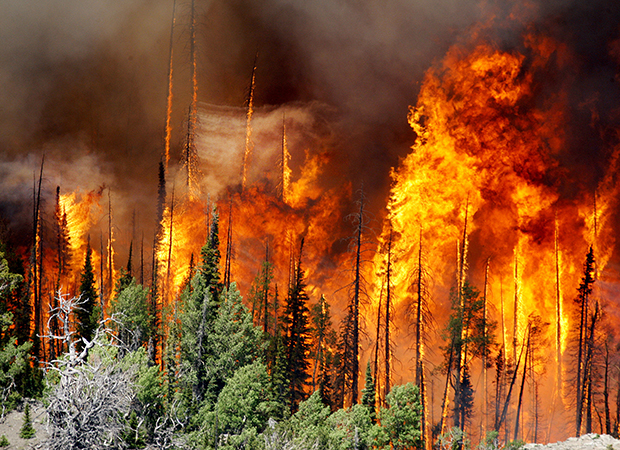Latter-day Saints in Fire-Vulnerable Areas Weathering Brian Head Fire
Contributed By Jason Swensen, Church News staff writer

The remains of a home destroyed by the Brian Head Fire are pictured on Friday, June 30, 2017. The evacuation order for Brian Head and Dry Lakes was lifted June 30, 13 days after residents were forced from their homes by the raging fire. Photo by Jeffrey D. Allred, Deseret News.
Article Highlights
- The cost of the fire on Latter-day Saints and Church-owned properties is still being assessed.
BRIAN HEAD, UTAH
Norma Stapley has lived in the tiny southern Utah town of Summit for more than six decades. There’s not a lot that happens here that she hasn’t seen before.
But the massive Brian Head Fire—which has burned more than 67,000 acres across southern Utah—marked a frightening first for Stapley and her neighbors.
“We’ve never seen anything like this before,” said the 80-year-old Primary teacher.
Over the past couple of weeks, Stapley has kept a wary eye on the smoke lingering above her community while maintaining close contact with friends in fire-vulnerable neighborhoods in the region.

Norma Stapley points to smoke-filled skies outside her Summit, Utah, home. The Brian Head Fire was burning not far from her southern Utah community. Photo by Jason Swensen.
The good news: while the Brian Head Fire has been both historic and damaging, it has not critically impacted Latter-day Saints in the region; no members or missionaries were harmed in the disaster.
A cabin owner reportedly using a torch to burn weeds sparked the forest fire on June 17. More than 1,500 people were forced at various times from homes and cabins. Meanwhile, almost 2,000 firefighters have been called upon to battle the blaze. As of Tuesday, July 4, about 70 percent of the wildfire had been contained.
Following a fortnight of fear, evacuations are being lifted, home and cabin owners are returning to their residences, and fire-impacted mountain roads are being reopened.
Bruce Muir, the Church’s humanitarian response director, said the cost of the fire on Latter-day Saints and Church-owned properties is still being assessed.
“We’ll have more information in the coming days,” he said.
Muir said the Church has shipped cleaning kits, hygiene kits, and other provisions to the region to help anyone impacted by the disaster.
More than a dozen homes and several other outbuildings were claimed by the wildfire. While it’s still unclear if any member families lost homes or cabins to the fire, there were several families who had to be evacuated.
“The members are doing well and staying with relatives and friends,” said Muir.

A firefighter works at Brian Head on Monday, June 19, 2017. Photo by Bode Mecham, U.S. Forest Service.
Many of those families belong to the Parowan 3rd Ward, Parowan Utah Stake. Bishop Roy Mathews said the fire has economically bruised other members in his ward.
“We do have families who work at the [fire-impacted] resorts,” he said, adding some will likely have to find jobs elsewhere.
Tourism is a key element of the Brian Head economy. Time is needed for business owners to get their establishments back in order—and for the tourists to return.
For many Brian Head businesses and their employees, the fire could not have happened at a worse moment. Holiday visitors swamp this region this time of year to enjoy Brian Head and the nearby national parks. It’s almost impossible to find hotel rooms in cities such as St. George and Hurricane.
“Some of the [Brian Head] businesses make 80 percent of their summer revenue just on the Fourth of July weekend, so it’s been a little scary for us the last couple of weeks,” Brian Head town manager Bret Howser told the Deseret News.
As the wildfire spread across sections of Iron County and neighboring Garfield County, many local members’ thoughts and prayers focused on the beloved Panguitch Lake Branch meetinghouse.
Located off Utah Highway 143 and just a short walk from Panguitch Lake, the tiny 13-year-old building is a seasonal sanctuary for both tourists and folks who live in mountain homes during the summer.
The road to Panguitch Lake is often closed during the winter, so the building is only in operation part of the year.
The meetinghouse is located on property a safe distance from the heavily wooded areas most vulnerable to wildfire. But Panguitch Utah Stake President Brady S. Eyre did worry the structure might suffer smoke damage. He knew he would not be able to access the evacuated area when fire threatened the area.
He contacted a sheriff’s deputy working in the area and asked him to shut down the building’s electricity so the air conditioning unit would not function and draw in smoky air.
“He told me the power was already out in the area,” said the relieved stake president.
The Panguitch Lake Branch building has been put to good use during the ongoing fire. Fire officials, law enforcement, and forestry service workers have used the structure as a staging and coordination center.

The LDS meetinghouse near Panguitch Lake in Utah’s Garfield Canyon suffered no significant damage during the ongoing Brian Head Fire. The building was being used as an operations center for fire and law enforcement officials. Photo by Jason Swensen.
The damage from the Brian Head Fire will be evident for years. More than 105 square miles of scenic forest has been destroyed. The scorched land will eventually return to its former majesty—but not anytime soon.
But there are signs of both resilience and gratitude.
Sister Stapley said she still has trouble breathing the smoke-tinged air, but on July 2 she observed the Sabbath teaching of a group of Primary kids from the Summit Ward.
Meanwhile, members and their neighbors from several southern Utah counties are giving thanks for the some 1,800 firefighters who arrived from several parts of the country to battle the threatening flames.

A message of appreciation for the scores of firefighters who have helped battle the historic Brian Head Fire in mountainous regions of southern Utah. Photo by Jason Swensen.
The fire crews have a dangerous job, but their skill and effort helped save lives and land while offering a measure of hope. Messages of thanks for the firefighters adorn business marquees and windows and the outside of government buildings from Panguitch to Parowan.

Homes that were spared from the Brian Head Fire are pictured on Friday, June 30, 2017. The evacuation order for Brian Head and Dry Lakes was lifted Friday, 13 days after residents were forced from their homes by the raging fire. Photo by Jeffrey D. Allred, Deseret News.

The Brian Head Fire, pictured Friday, June 23, 2017. At least 13 homes and eight outbuildings have been destroyed by the fire. Photo by Stuart Johnson, Deseret News.

Firefighters work at Brian Head on Monday, June 19, 2017.
